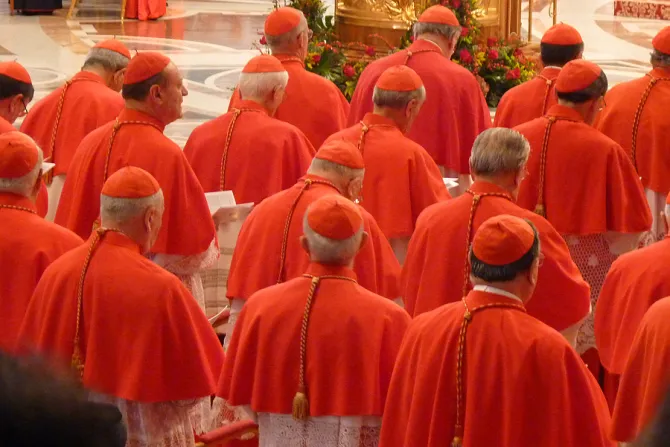Vatican City, May 22, 2017 / 14:08 pm
Only seven months after Pope Francis' last consistory, he will create five new cardinals in June. He continues a pattern of finding cardinals at the peripheries of the world, from dioceses which have not traditionally had a cardinal.
The next consistory will take place June 28.
In this new batch Pope Francis has confirmed his preference for dioceses that are not traditional sees for a cardinal. For instance, this is the first time a bishop from El Salvador, Sweden, Mali, and Laos will receive a red hat.
The Pope's choice of Bishop Louis Marie Ling Mangkhanekhoun, Vicar Apostolic of Paksé, reveals his particular interest in Laos.
Laos, a one-party communist republic averse to religion, is one of the few countries lacking full diplomatic relations with the Holy See.
However, in recent years the Laotian government has been showing a greater openness to the international community, and also to the religious sentiment of its mostly Buddhist population.
There are only 45,000 Catholics in Laos, less than one percent of the 7 million Laotians. Laos has no dioceses: there are only three apostolic vicariates with 22 priests and 11 religious priests. Three new priests were ordained in the country in 2016, and two more will be ordained this year.
The beatification of Italian missionary Mario Borzaga, of the Laotian priest Joseph Thao Thien and 14 companions martyred in 1960 gave more impetus to the Laotian "baby Church," to use Bishop Mangkhanekhoun's words.
The beatification Mass took place in Vientiane on Dec. 11, 2016, with the participation of over 7,000 faithful. The government's permission for the public celebration was considered a sign that the Laotian government is changing its hostile attitude towards religion. Meanwhile, the Holy See is trying to establish full diplomatic ties with the country in order to better protect the Catholic flock.
In Mali, the red biretta for Archbishop Jean Zerbo of Bamao can also be read through diplomatic lense.
Archbishop Zerbo has strongly committed to the ongoing dialogue for reconciliation in his country. In 2012, Al-Qaeda exploited a rebellion carried out by ethnic Tuaregs and tried to take control of the central government. Ever since, Mali has been living in a constant political crisis that has turned into a refugee crisis.
His elevation as cardinal will give Archbishop Zerbo more weight in the peace talks.
After his trip to Sweden late last year, Pope Francis also named as cardinal Bishop Anders Arborelius of Stockholm.
Bishop Arborelius, a convert from Lutheranism, is the first Swedish-born Catholic bishop in the country since the Lutheran Reformation.
In El Salvador, Bishop José Gregorio Rosa Chavez, auxiliary bishop of San Salvador, is the first auxiliary bishop ever to be appointed a cardinal while the bishop in charge of his archdiocese remains but a bishop.
His red biretta may be considered a reward for his service to El Salvador in his more than 30 years as auxiliary bishop, especially during the difficult years of the 1980-1992 civil war.
In contrast to other cardinals-to-be, the red hat for Archbishop Juan José Omella Omella is not a dramatic departure from tradition, as Barcelona is traditionally a see with a cardinal. Archbishop Omella's predecessor, Cardinal Lluis Martinez Sistach, turned 80 on Apr. 29.
(Story continues below)
The announcement that Archbishop Omella will be created a cardinal comes only two days after the new presidency of the Spanish Bishops' Conference met with Pope Francis in a private audience in Rome.
The Spanish Bishops' Conference gathered for its general assembly in Madrid on March 15. Cardinal Ricardo Blázquez Pérez was re-elected as president for a second three-year mandate by a strong majority. Cardinal Antonio Cañizares Llovera, archbishop of Valencia and former prefect of the Congregation for Divine Worship, was elected vice-president.
In the race for the presidency, Cardinal Carlos Osoro Sierra of Madrid, got four votes, while Archbishop Omella got just one vote.
By naming Archbishop Omella a cardinal, the Pope might want to show the Spanish Bishops' Conference the men in whom he places his trust. The two Spaniards, Cardinal Osoro Sierra, appointed by Pope Francis as Archbishop of Madrid, and Archbishop Omella will have gotten their red hats in back to back consistories only seven months apart.
All of the new cardinals are below 80, so they all have the right to vote in a conclave to elect a Pope. Sweden's Bishop Anders Arborelius is the youngest, as he will turn 68 in September, while Bishop Rosa is the oldest, about to turn 75.
In the last consistory, 13 out of 17 new red hats were given to bishops or archbishops below the age of 80.
Church rules set the maximum number of cardinal electors in a conclave at 120.
With the five new cardinals, Pope Francis has the increased the number of voting cardinals to 121, exceeding the limit by one.
The five new cardinals also slightly re-shape the composition of the College of Cardinals. After the June 28 consistory, Europe will be represented by 53 voting cardinals, compared with 51 at present. Central America's voting cardinals will increase to five from four. Africa and Asia combined will have 15 cardinals in a prospective conclave, an increase of one.
Other regions' number of cardinal electors is unchanged: North America still has 17 voting cardinals, South America has 12, and Oceania four.
Up to now, Pope Francis has created 61 cardinals: 49 voting cardinals, and 12 non-voting. The college of voting cardinals is completed by 52 cardinals created by Benedict XVI, and 20 by St. John Paul II.



